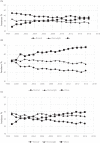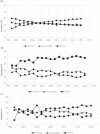Obesity Trends among Asthma Patients in the United States: A Population-based Study
- PMID: 30741512
- PMCID: PMC7052313
- DOI: 10.5334/aogh.2420
Obesity Trends among Asthma Patients in the United States: A Population-based Study
Abstract
Background: Obesity is strongly associated with worse asthma control and poorer quality of life. The current obesity epidemic has reached historically high levels, with an estimated prevalence rate of 37% in the general United States (US) population. However, less is known about trends in the prevalence of obesity among individuals with asthma or which sociodemographic groups are at higher risk for increased weight.
Methods: The study was conducted with data from the Behavioral Risk Factor Surveillance System (BRFSS) study, a nationally representative probability-based sample of the US population. We included participants ≥18 years of age who were interviewed between 1999 and 2016. Using stratified weighting, we estimated the annual prevalence of participants with, and without a diagnosis of asthma, classified according to their body mass index (BMI), into: normal weight (18.5-25 kg/m2), overweight (25-30 kg/m2), or obese (>30 kg/m2). We calculated the annual odds of obesity among participants with vs. without asthma to assess if trends among individuals with asthma followed those of the general US population. Nominal regression analysis assessed the association between age, sex, race/ethnicity, and income with prevalence of obesity among participants with asthma.
Results: Among the 543,574 BRSFF participants with asthma, the prevalence of overweight and obesity changed from 34.3% and 24.7% in 1999 to 28.8% and 41.1% in 2016, respectively. The odds ratio (OR) of obesity in patients with asthma compared to the general population without asthma, increased during the same period from 1.39 (95% confidence interval [CI]: 1.36-1.36) in 1999 to 1.75 (95% CI: 1.75-1.76) in 2016. Adjusted analysis showed that older (OR: 2.32, 95% CI: 2.32-2.33), Black (OR: 1.61, 95% CI: 1.61-1.61) and Hispanic (OR: 1.29, 95%. CI: 1.28-1.29) participants with asthma had higher rates of obesity.
Conclusions: There has been a substantial increase in the prevalence of obesity among individuals with asthma in the last two decades, beyond what could be explained by general population trends. These results suggest that obesity is an increasing determinant of asthma morbidity and should be particularly targeted in minorities with asthma.
© 2019 The Author(s). This is an open-access article distributed under the terms of the Creative Commons Attribution 4.0 International License (CC-BY 4.0), which permits unrestricted use, distribution, and reproduction in any medium, provided the original author and source are credited. See http://creativecommons.org/licenses/by/4.0/.
Conflict of interest statement
The authors have no competing interests to declare.
Figures





Similar articles
-
Core state preconception health indicators - pregnancy risk assessment monitoring system and behavioral risk factor surveillance system, 2009.MMWR Surveill Summ. 2014 Apr 25;63(3):1-62. MMWR Surveill Summ. 2014. PMID: 24759729
-
State-specific prevalence of selected chronic disease-related characteristics--Behavioral Risk Factor Surveillance System, 2001.MMWR Surveill Summ. 2003 Aug 22;52(8):1-80. MMWR Surveill Summ. 2003. PMID: 14532868
-
Prevalence and trends in obesity among US adults, 1999-2000.JAMA. 2002 Oct 9;288(14):1723-7. doi: 10.1001/jama.288.14.1723. JAMA. 2002. PMID: 12365955
-
Body mass index and the risk of asthma in adults.Respir Med. 2004 Jan;98(1):29-37. doi: 10.1016/j.rmed.2003.08.004. Respir Med. 2004. PMID: 14959811
-
Obesity and asthma.Immunol Allergy Clin North Am. 2008 Aug;28(3):589-602, ix. doi: 10.1016/j.iac.2008.03.003. Immunol Allergy Clin North Am. 2008. PMID: 18572109 Free PMC article. Review.
Cited by
-
Pilot study of a brief provider and EMR-based intervention for overweight teens with asthma.Pilot Feasibility Stud. 2021 Aug 30;7(1):167. doi: 10.1186/s40814-021-00848-6. Pilot Feasibility Stud. 2021. PMID: 34462008 Free PMC article.
-
Patterns and trends in asthma incidence rates in main Asian and Western countries and their prediction to 2030.Chin Med J Pulm Crit Care Med. 2024 Sep 17;2(3):188-196. doi: 10.1016/j.pccm.2024.08.004. eCollection 2024 Sep. Chin Med J Pulm Crit Care Med. 2024. PMID: 39403411 Free PMC article.
-
Utility of Hypoglycemic Agents to Treat Asthma with Comorbid Obesity.Pulm Ther. 2023 Mar;9(1):71-89. doi: 10.1007/s41030-022-00211-x. Epub 2022 Dec 27. Pulm Ther. 2023. PMID: 36575356 Free PMC article. Review.
-
Weight Loss Interventions for Adults With Obesity-Related Asthma.J Allergy Clin Immunol Pract. 2024 Apr;12(4):840-847. doi: 10.1016/j.jaip.2023.12.041. Epub 2023 Dec 28. J Allergy Clin Immunol Pract. 2024. PMID: 38159807 Free PMC article.
-
Impact of obesity on airway remodeling in asthma: pathophysiological insights and clinical implications.Front Allergy. 2024 Mar 18;5:1365801. doi: 10.3389/falgy.2024.1365801. eCollection 2024. Front Allergy. 2024. PMID: 38562155 Free PMC article. Review.
References
-
- World Health Organization. Asthma Fact Sheet; 2017. http://www.who.int/mediacentre/factsheets/fs307/en/.
-
- Mannino DM, Homa DM, Pertowski CA, Ashizawa A, Nixon LL, Johnson CA, et al. Surveillance for asthma—United States, 1960–1995. MMWR CDC Surveill Summ. 1998; 47(1): 1–27. - PubMed
Publication types
MeSH terms
Grants and funding
LinkOut - more resources
Full Text Sources
Medical
Miscellaneous

